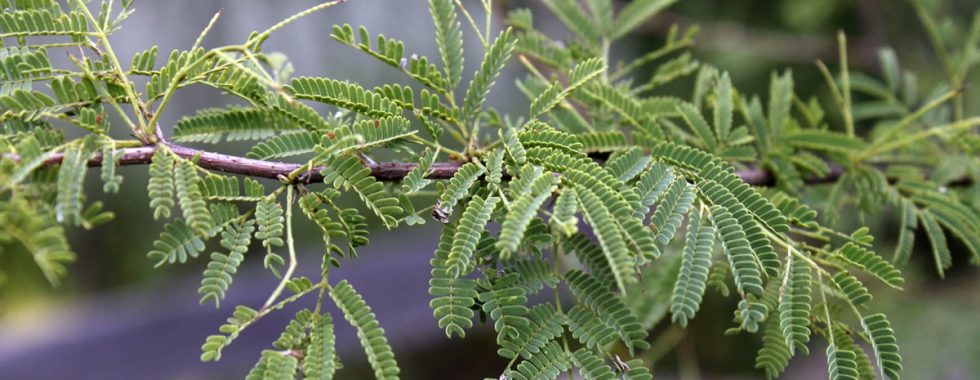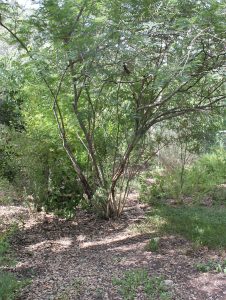Trail Notes: The Survivors
I won’t lie to you. The combined drought and heat we’ve been experiencing here in Central Texas has been downright ugly. And it’s been deadly as well. Even many of the plants we’ve come to rely on to make it through the summer and bloom for pollinators in the fall, plants such as frostweed and Turk’s cap, are looking awfully sad.
Consequently, rather than brave the 110-degree heat in search of something to showcase, I’m sticking close to home this month. Though many of my native plants look pretty bad, I’ve noticed a few things that seem surprisingly unfazed by the scorching temperatures. Granted, everything appreciates a drink now and then, but some plants obviously cope with drought better than others. These are a few of those survivors in my home landscape.
Huisache
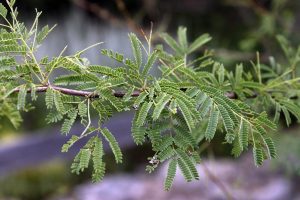 Prior to the freeze of 2021, virtually every pasture between San Marcos and San Antonio was thick with huisache trees. The same was true in many undeveloped areas to the west of town. The cold killed quite a few of these trees, but a good number of them survived and came back from the roots, including the one growing in a sunny and rocky spot at the corner of our yard.
Prior to the freeze of 2021, virtually every pasture between San Marcos and San Antonio was thick with huisache trees. The same was true in many undeveloped areas to the west of town. The cold killed quite a few of these trees, but a good number of them survived and came back from the roots, including the one growing in a sunny and rocky spot at the corner of our yard.
Common as they are, huisache trees frequently go unnoticed until they begin to bloom, usually in March or April. Their brilliant yellow-orange flowers, though small, are exceptionally fragrant and, en masse, appear as a cloud of gold even from a distance.
Also known as “sweet acacia,” huisache is a 15-20-foot tall multitrunked tree or shrub with small, fern-like leaves. Though its wicked thorns and ability to spread make it a nuisance to many ranchers, those same qualities are valued by wildlife and native plant enthusiasts. The tree’s abundant seeds serve as food for dove and deer, its spring flowers provide nectar for hummingbirds and a variety of insects, and those inches-long thorns offer great protection for nesting birds and other animals.
I like to think of the guajillo as the huisache’s sweeter, more genteel and gentle cousin. Also a multi-trunked acacia that can reach 15 feet in height, this thornless shrub or small tree bears exceptionally fragrant cream-colored flowers in the spring. Not surprisingly, my introduction to this plant was by a beekeeper who gifted me with a jar of his prized guajillo honey, considered by many to be the best in Texas.
Unlike the huisache that sits in direct sun by the street, my two guajillo trees grow in our shady backyard. Each has frozen to the ground at least once in its life, but in time they grew back. Today, both are more than 12 feet tall.
Texas Ebony
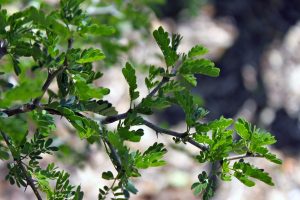 With rounded and leathery dark-green leaves, Texas ebony is an often multi-trunked tree that can reach 40 feet in height. Though it’s a slow grower, this tree can ultimately become a beautiful single-trunked tree that provides heavy shade.
With rounded and leathery dark-green leaves, Texas ebony is an often multi-trunked tree that can reach 40 feet in height. Though it’s a slow grower, this tree can ultimately become a beautiful single-trunked tree that provides heavy shade.
Like the acacias it resembles, primarily because of the shape of its leaves and the abundance of long thorns, Texas ebony produces fragrant cream-colored flowers that attract butterflies and bees. Its seed pods also provide food for a variety of mammals.
Although I’ve recently seen small ebony trees for sale in an area native plant nursery, my own tree came from one of several seeds I brought home from far South Texas more than 20 years ago. As often happened, I evidently planted the seeds in various spots in the yard and then forgot about them. Several years passed before I noticed an interesting looking seedling coming up in the shade of a small Mexican olive near the street. Something about it seemed familiar, and as it turned out, it was a Texas ebony. Fortunately, I’ve long had the habit of leaving “mystery plants” alone until they can be identified, a practice that allowed the ebony to remain in place. Today it still grows beneath that Mexican olive—even though both trees were damaged by the freeze of 2021 and had to come back from the roots.
Desert Willow
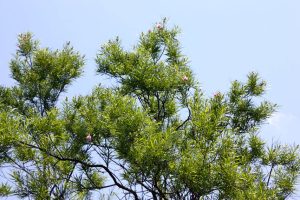 Though definitely a survivor at more than 20 years old and 25 feet tall, our desert willow is not without its scars. Over time it’s been crowded by other trees, and the resulting dead limbs have had to be removed, leaving it lesser than it once was.
Though definitely a survivor at more than 20 years old and 25 feet tall, our desert willow is not without its scars. Over time it’s been crowded by other trees, and the resulting dead limbs have had to be removed, leaving it lesser than it once was.
That said, I was thrilled to look up one recent day to see a pink bloom atop the tree. It was happily alive.
A fast-growing, drought-tolerant ornamental that can reach 40 feet, desert willow likes well-draining limestone or sandy soils. Related to the catalpa and trumpet creeper, rather than the willow it closely resembles, desert willow produces a fragrant orchid-like pink to lavender flower that attracts hummingbirds and nectar-loving insects, including bees and butterflies.
Mexican Olive
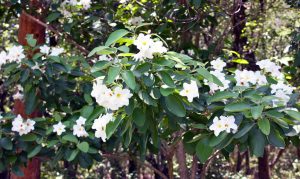 The Mexican olive is an anomaly in a way. Unlike most plants that thrive in hot weather, this species sports large, velvety leaves—something that would normally result in a great loss of water for the tree.
The Mexican olive is an anomaly in a way. Unlike most plants that thrive in hot weather, this species sports large, velvety leaves—something that would normally result in a great loss of water for the tree.
Another South Texas native, the Mexican olive, or anacahuita, can be pruned into a beautiful tree, ultimately reaching 30 feet in height. Although it loves the sun, it can also be grown in part shade. It’s a prolific bloomer, bearing a great number of large trumpet-shaped white flowers—provided it’s had enough rain. The blooms are a great draw for hummingbirds and a variety of butterflies, particularly swallowtails, and the fruit are enjoyed by birds and mammals.
I currently have four Mexican olives in my yard, all located in full to partial shade, in defiance of the stated growing conditions. Two of these I’ve had for almost 45 years, in spite of events that should have killed them long ago. Most dramatically, both were cut to the ground by an over-zealous tree trimmer; instead of removing two paper mulberries that were growing in the dog pen, he chopped down the two Mexican olive trees that my mother had planted when we moved into our house. They were roughly 15 feet tall at the time. I cried and then waited to see what would happen. The trees came back. They’ve also frozen to the ground several times, but returned then, too. At present, they look just fine, though they haven’t bloomed in a while.
Goldenball Leadtree
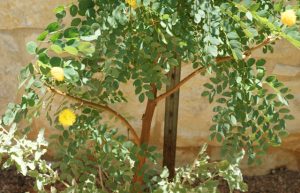 Another plant that seems to be faring well during the current drought is the goldenball leadtree, also known as the littleleaf leadtree. Like the guajillos that grow nearby, this tree bears sweet-smelling puffy flowers in warm weather, usually after rains—but gold instead of cream-colored.
Another plant that seems to be faring well during the current drought is the goldenball leadtree, also known as the littleleaf leadtree. Like the guajillos that grow nearby, this tree bears sweet-smelling puffy flowers in warm weather, usually after rains—but gold instead of cream-colored.
A multi-trunked tree that can reach 25 feet, the goldenball leadtree normally grows in rocky, limestone areas and is happy in just about any well-drained soil. My own tree, which I planted in 1996 in memory of my mother—it was her favorite tree, in that it was plentiful where she grew up on the Edward’s Plateau—drapes high over our deck. It’s put out a number of small branches lately, but many of those have been broken off by the naughty squirrels and raccoons that reside in our backyard.
Written by Susan Hanson, editor, The Loop.

